Health Law and Ethics Essay 2022
VerifiedAdded on 2022/10/06
|6
|2136
|69
Essay
AI Summary
Contribute Materials
Your contribution can guide someone’s learning journey. Share your
documents today.
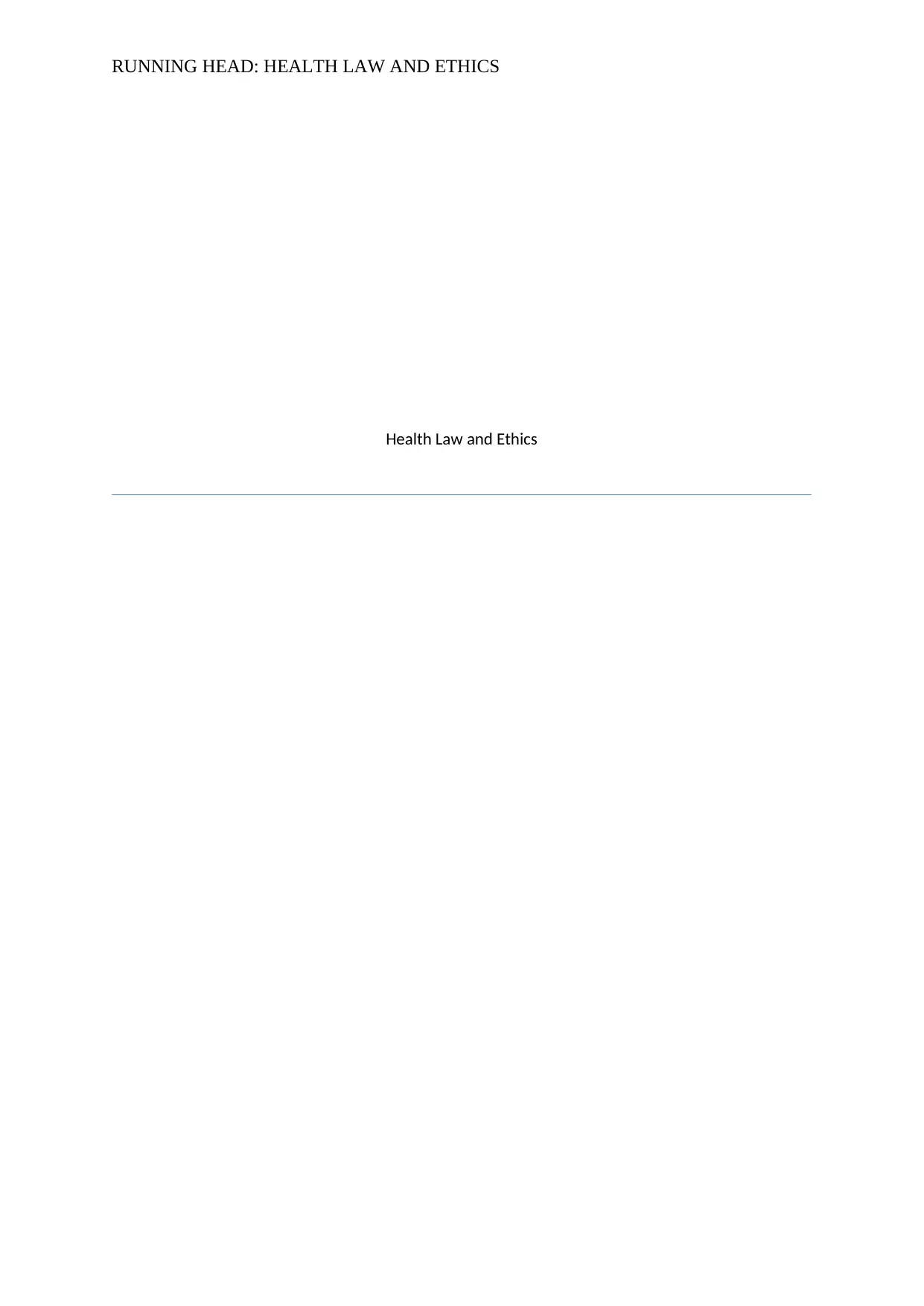
RUNNING HEAD: HEALTH LAW AND ETHICS
Health Law and Ethics
Health Law and Ethics
Secure Best Marks with AI Grader
Need help grading? Try our AI Grader for instant feedback on your assignments.
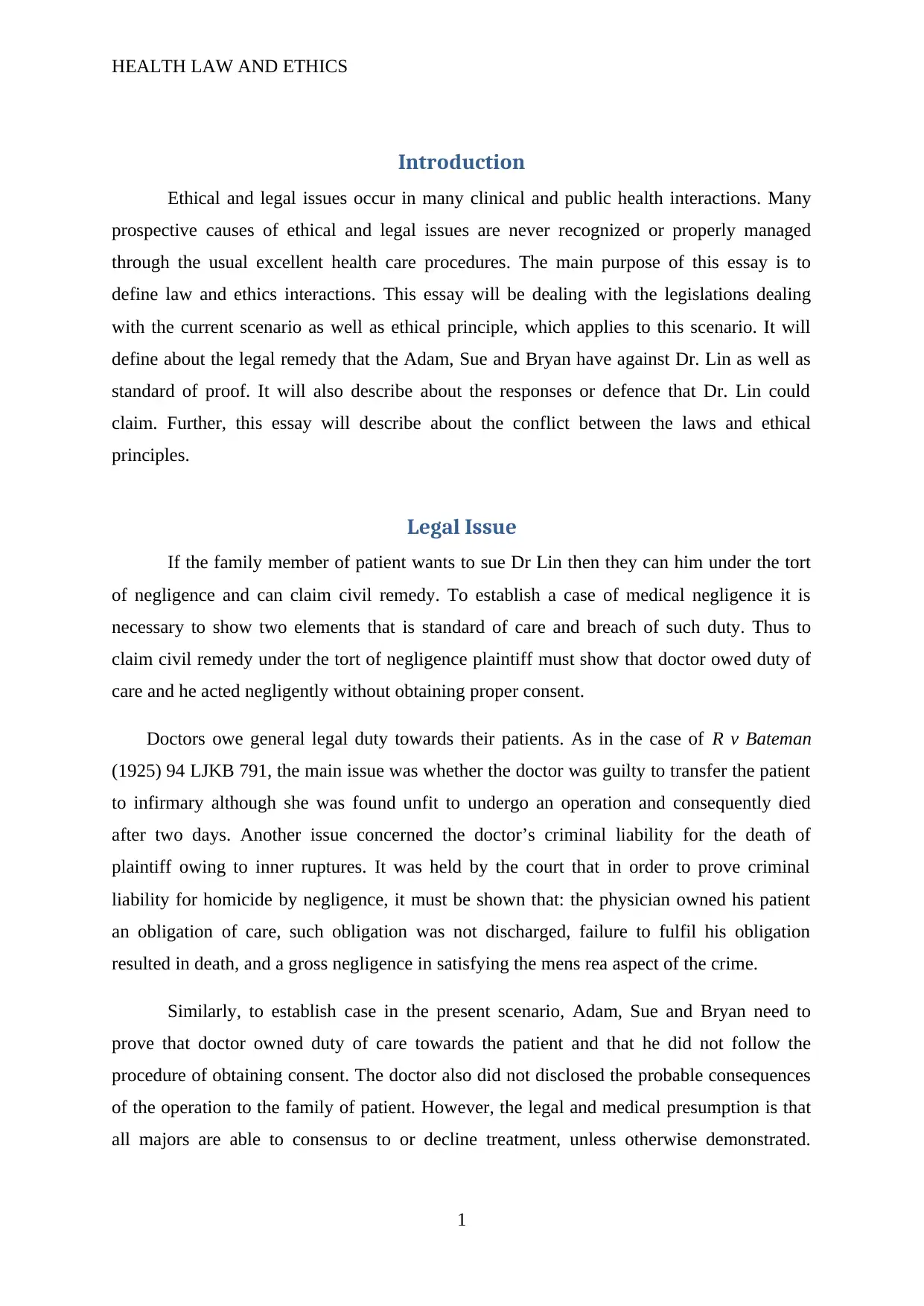
HEALTH LAW AND ETHICS
Introduction
Ethical and legal issues occur in many clinical and public health interactions. Many
prospective causes of ethical and legal issues are never recognized or properly managed
through the usual excellent health care procedures. The main purpose of this essay is to
define law and ethics interactions. This essay will be dealing with the legislations dealing
with the current scenario as well as ethical principle, which applies to this scenario. It will
define about the legal remedy that the Adam, Sue and Bryan have against Dr. Lin as well as
standard of proof. It will also describe about the responses or defence that Dr. Lin could
claim. Further, this essay will describe about the conflict between the laws and ethical
principles.
Legal Issue
If the family member of patient wants to sue Dr Lin then they can him under the tort
of negligence and can claim civil remedy. To establish a case of medical negligence it is
necessary to show two elements that is standard of care and breach of such duty. Thus to
claim civil remedy under the tort of negligence plaintiff must show that doctor owed duty of
care and he acted negligently without obtaining proper consent.
Doctors owe general legal duty towards their patients. As in the case of R v Bateman
(1925) 94 LJKB 791, the main issue was whether the doctor was guilty to transfer the patient
to infirmary although she was found unfit to undergo an operation and consequently died
after two days. Another issue concerned the doctor’s criminal liability for the death of
plaintiff owing to inner ruptures. It was held by the court that in order to prove criminal
liability for homicide by negligence, it must be shown that: the physician owned his patient
an obligation of care, such obligation was not discharged, failure to fulfil his obligation
resulted in death, and a gross negligence in satisfying the mens rea aspect of the crime.
Similarly, to establish case in the present scenario, Adam, Sue and Bryan need to
prove that doctor owned duty of care towards the patient and that he did not follow the
procedure of obtaining consent. The doctor also did not disclosed the probable consequences
of the operation to the family of patient. However, the legal and medical presumption is that
all majors are able to consensus to or decline treatment, unless otherwise demonstrated.
1
Introduction
Ethical and legal issues occur in many clinical and public health interactions. Many
prospective causes of ethical and legal issues are never recognized or properly managed
through the usual excellent health care procedures. The main purpose of this essay is to
define law and ethics interactions. This essay will be dealing with the legislations dealing
with the current scenario as well as ethical principle, which applies to this scenario. It will
define about the legal remedy that the Adam, Sue and Bryan have against Dr. Lin as well as
standard of proof. It will also describe about the responses or defence that Dr. Lin could
claim. Further, this essay will describe about the conflict between the laws and ethical
principles.
Legal Issue
If the family member of patient wants to sue Dr Lin then they can him under the tort
of negligence and can claim civil remedy. To establish a case of medical negligence it is
necessary to show two elements that is standard of care and breach of such duty. Thus to
claim civil remedy under the tort of negligence plaintiff must show that doctor owed duty of
care and he acted negligently without obtaining proper consent.
Doctors owe general legal duty towards their patients. As in the case of R v Bateman
(1925) 94 LJKB 791, the main issue was whether the doctor was guilty to transfer the patient
to infirmary although she was found unfit to undergo an operation and consequently died
after two days. Another issue concerned the doctor’s criminal liability for the death of
plaintiff owing to inner ruptures. It was held by the court that in order to prove criminal
liability for homicide by negligence, it must be shown that: the physician owned his patient
an obligation of care, such obligation was not discharged, failure to fulfil his obligation
resulted in death, and a gross negligence in satisfying the mens rea aspect of the crime.
Similarly, to establish case in the present scenario, Adam, Sue and Bryan need to
prove that doctor owned duty of care towards the patient and that he did not follow the
procedure of obtaining consent. The doctor also did not disclosed the probable consequences
of the operation to the family of patient. However, the legal and medical presumption is that
all majors are able to consensus to or decline treatment, unless otherwise demonstrated.
1
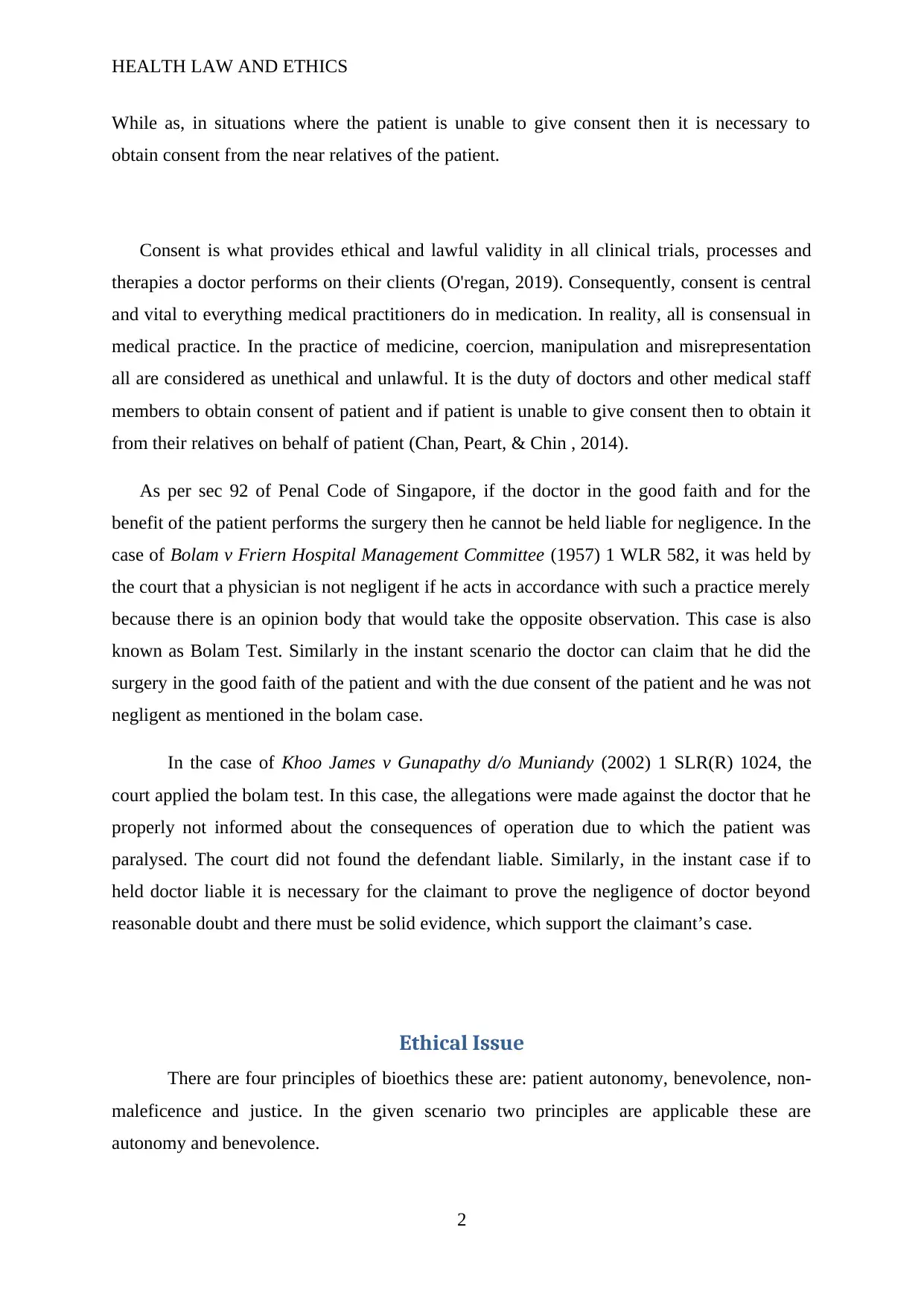
HEALTH LAW AND ETHICS
While as, in situations where the patient is unable to give consent then it is necessary to
obtain consent from the near relatives of the patient.
Consent is what provides ethical and lawful validity in all clinical trials, processes and
therapies a doctor performs on their clients (O'regan, 2019). Consequently, consent is central
and vital to everything medical practitioners do in medication. In reality, all is consensual in
medical practice. In the practice of medicine, coercion, manipulation and misrepresentation
all are considered as unethical and unlawful. It is the duty of doctors and other medical staff
members to obtain consent of patient and if patient is unable to give consent then to obtain it
from their relatives on behalf of patient (Chan, Peart, & Chin , 2014).
As per sec 92 of Penal Code of Singapore, if the doctor in the good faith and for the
benefit of the patient performs the surgery then he cannot be held liable for negligence. In the
case of Bolam v Friern Hospital Management Committee (1957) 1 WLR 582, it was held by
the court that a physician is not negligent if he acts in accordance with such a practice merely
because there is an opinion body that would take the opposite observation. This case is also
known as Bolam Test. Similarly in the instant scenario the doctor can claim that he did the
surgery in the good faith of the patient and with the due consent of the patient and he was not
negligent as mentioned in the bolam case.
In the case of Khoo James v Gunapathy d/o Muniandy (2002) 1 SLR(R) 1024, the
court applied the bolam test. In this case, the allegations were made against the doctor that he
properly not informed about the consequences of operation due to which the patient was
paralysed. The court did not found the defendant liable. Similarly, in the instant case if to
held doctor liable it is necessary for the claimant to prove the negligence of doctor beyond
reasonable doubt and there must be solid evidence, which support the claimant’s case.
Ethical Issue
There are four principles of bioethics these are: patient autonomy, benevolence, non-
maleficence and justice. In the given scenario two principles are applicable these are
autonomy and benevolence.
2
While as, in situations where the patient is unable to give consent then it is necessary to
obtain consent from the near relatives of the patient.
Consent is what provides ethical and lawful validity in all clinical trials, processes and
therapies a doctor performs on their clients (O'regan, 2019). Consequently, consent is central
and vital to everything medical practitioners do in medication. In reality, all is consensual in
medical practice. In the practice of medicine, coercion, manipulation and misrepresentation
all are considered as unethical and unlawful. It is the duty of doctors and other medical staff
members to obtain consent of patient and if patient is unable to give consent then to obtain it
from their relatives on behalf of patient (Chan, Peart, & Chin , 2014).
As per sec 92 of Penal Code of Singapore, if the doctor in the good faith and for the
benefit of the patient performs the surgery then he cannot be held liable for negligence. In the
case of Bolam v Friern Hospital Management Committee (1957) 1 WLR 582, it was held by
the court that a physician is not negligent if he acts in accordance with such a practice merely
because there is an opinion body that would take the opposite observation. This case is also
known as Bolam Test. Similarly in the instant scenario the doctor can claim that he did the
surgery in the good faith of the patient and with the due consent of the patient and he was not
negligent as mentioned in the bolam case.
In the case of Khoo James v Gunapathy d/o Muniandy (2002) 1 SLR(R) 1024, the
court applied the bolam test. In this case, the allegations were made against the doctor that he
properly not informed about the consequences of operation due to which the patient was
paralysed. The court did not found the defendant liable. Similarly, in the instant case if to
held doctor liable it is necessary for the claimant to prove the negligence of doctor beyond
reasonable doubt and there must be solid evidence, which support the claimant’s case.
Ethical Issue
There are four principles of bioethics these are: patient autonomy, benevolence, non-
maleficence and justice. In the given scenario two principles are applicable these are
autonomy and benevolence.
2
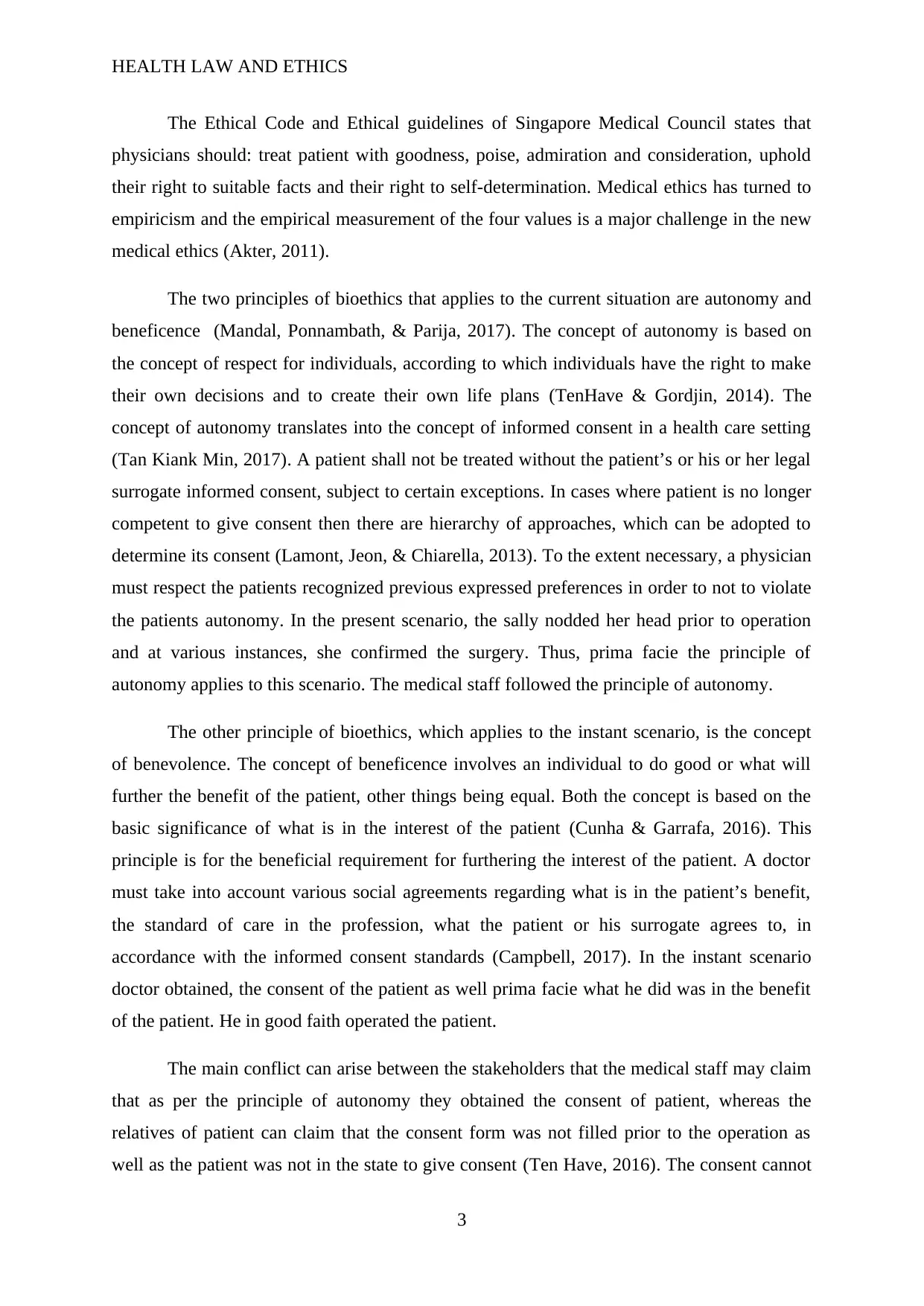
HEALTH LAW AND ETHICS
The Ethical Code and Ethical guidelines of Singapore Medical Council states that
physicians should: treat patient with goodness, poise, admiration and consideration, uphold
their right to suitable facts and their right to self-determination. Medical ethics has turned to
empiricism and the empirical measurement of the four values is a major challenge in the new
medical ethics (Akter, 2011).
The two principles of bioethics that applies to the current situation are autonomy and
beneficence (Mandal, Ponnambath, & Parija, 2017). The concept of autonomy is based on
the concept of respect for individuals, according to which individuals have the right to make
their own decisions and to create their own life plans (TenHave & Gordjin, 2014). The
concept of autonomy translates into the concept of informed consent in a health care setting
(Tan Kiank Min, 2017). A patient shall not be treated without the patient’s or his or her legal
surrogate informed consent, subject to certain exceptions. In cases where patient is no longer
competent to give consent then there are hierarchy of approaches, which can be adopted to
determine its consent (Lamont, Jeon, & Chiarella, 2013). To the extent necessary, a physician
must respect the patients recognized previous expressed preferences in order to not to violate
the patients autonomy. In the present scenario, the sally nodded her head prior to operation
and at various instances, she confirmed the surgery. Thus, prima facie the principle of
autonomy applies to this scenario. The medical staff followed the principle of autonomy.
The other principle of bioethics, which applies to the instant scenario, is the concept
of benevolence. The concept of beneficence involves an individual to do good or what will
further the benefit of the patient, other things being equal. Both the concept is based on the
basic significance of what is in the interest of the patient (Cunha & Garrafa, 2016). This
principle is for the beneficial requirement for furthering the interest of the patient. A doctor
must take into account various social agreements regarding what is in the patient’s benefit,
the standard of care in the profession, what the patient or his surrogate agrees to, in
accordance with the informed consent standards (Campbell, 2017). In the instant scenario
doctor obtained, the consent of the patient as well prima facie what he did was in the benefit
of the patient. He in good faith operated the patient.
The main conflict can arise between the stakeholders that the medical staff may claim
that as per the principle of autonomy they obtained the consent of patient, whereas the
relatives of patient can claim that the consent form was not filled prior to the operation as
well as the patient was not in the state to give consent (Ten Have, 2016). The consent cannot
3
The Ethical Code and Ethical guidelines of Singapore Medical Council states that
physicians should: treat patient with goodness, poise, admiration and consideration, uphold
their right to suitable facts and their right to self-determination. Medical ethics has turned to
empiricism and the empirical measurement of the four values is a major challenge in the new
medical ethics (Akter, 2011).
The two principles of bioethics that applies to the current situation are autonomy and
beneficence (Mandal, Ponnambath, & Parija, 2017). The concept of autonomy is based on
the concept of respect for individuals, according to which individuals have the right to make
their own decisions and to create their own life plans (TenHave & Gordjin, 2014). The
concept of autonomy translates into the concept of informed consent in a health care setting
(Tan Kiank Min, 2017). A patient shall not be treated without the patient’s or his or her legal
surrogate informed consent, subject to certain exceptions. In cases where patient is no longer
competent to give consent then there are hierarchy of approaches, which can be adopted to
determine its consent (Lamont, Jeon, & Chiarella, 2013). To the extent necessary, a physician
must respect the patients recognized previous expressed preferences in order to not to violate
the patients autonomy. In the present scenario, the sally nodded her head prior to operation
and at various instances, she confirmed the surgery. Thus, prima facie the principle of
autonomy applies to this scenario. The medical staff followed the principle of autonomy.
The other principle of bioethics, which applies to the instant scenario, is the concept
of benevolence. The concept of beneficence involves an individual to do good or what will
further the benefit of the patient, other things being equal. Both the concept is based on the
basic significance of what is in the interest of the patient (Cunha & Garrafa, 2016). This
principle is for the beneficial requirement for furthering the interest of the patient. A doctor
must take into account various social agreements regarding what is in the patient’s benefit,
the standard of care in the profession, what the patient or his surrogate agrees to, in
accordance with the informed consent standards (Campbell, 2017). In the instant scenario
doctor obtained, the consent of the patient as well prima facie what he did was in the benefit
of the patient. He in good faith operated the patient.
The main conflict can arise between the stakeholders that the medical staff may claim
that as per the principle of autonomy they obtained the consent of patient, whereas the
relatives of patient can claim that the consent form was not filled prior to the operation as
well as the patient was not in the state to give consent (Ten Have, 2016). The consent cannot
3
Secure Best Marks with AI Grader
Need help grading? Try our AI Grader for instant feedback on your assignments.
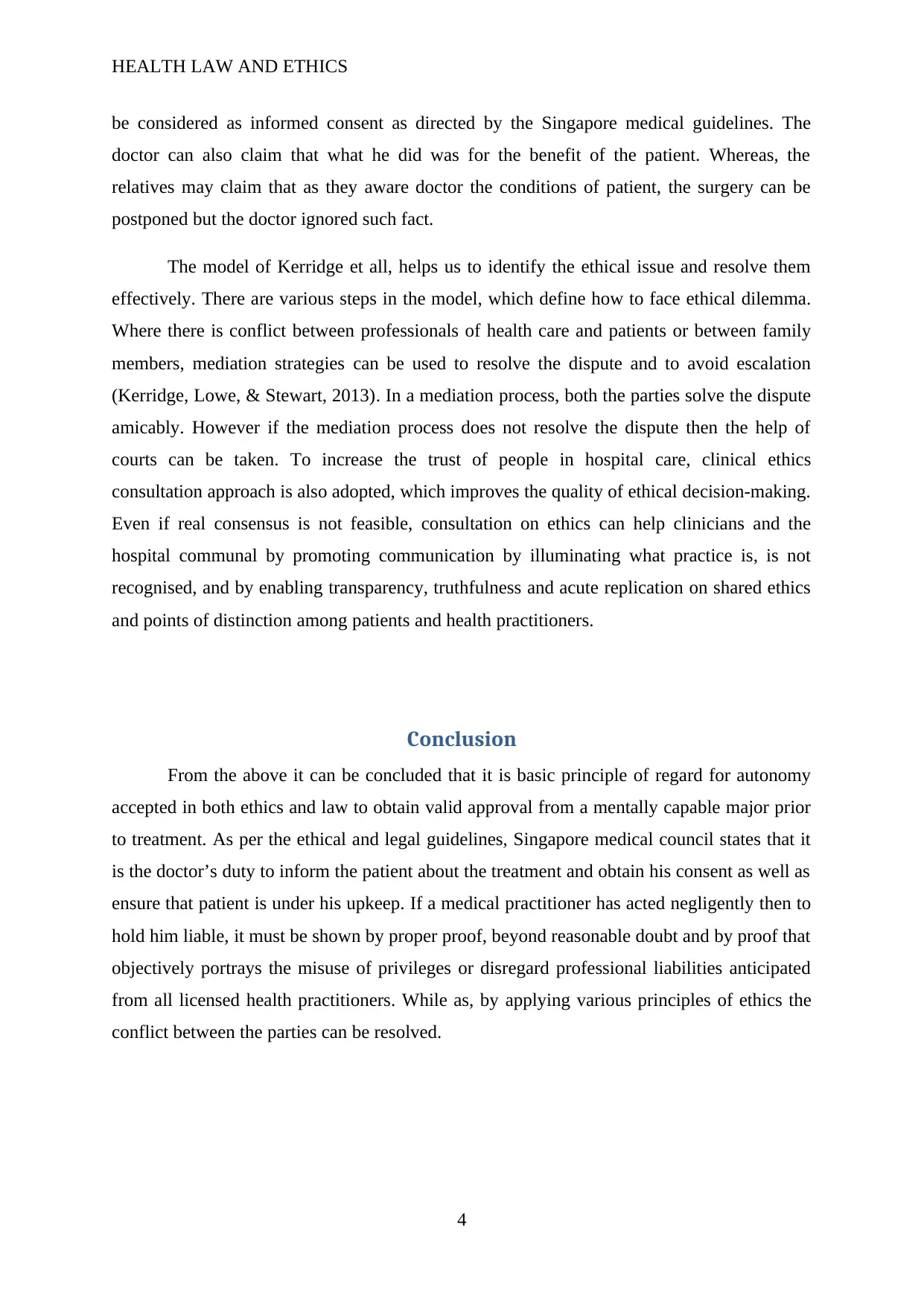
HEALTH LAW AND ETHICS
be considered as informed consent as directed by the Singapore medical guidelines. The
doctor can also claim that what he did was for the benefit of the patient. Whereas, the
relatives may claim that as they aware doctor the conditions of patient, the surgery can be
postponed but the doctor ignored such fact.
The model of Kerridge et all, helps us to identify the ethical issue and resolve them
effectively. There are various steps in the model, which define how to face ethical dilemma.
Where there is conflict between professionals of health care and patients or between family
members, mediation strategies can be used to resolve the dispute and to avoid escalation
(Kerridge, Lowe, & Stewart, 2013). In a mediation process, both the parties solve the dispute
amicably. However if the mediation process does not resolve the dispute then the help of
courts can be taken. To increase the trust of people in hospital care, clinical ethics
consultation approach is also adopted, which improves the quality of ethical decision-making.
Even if real consensus is not feasible, consultation on ethics can help clinicians and the
hospital communal by promoting communication by illuminating what practice is, is not
recognised, and by enabling transparency, truthfulness and acute replication on shared ethics
and points of distinction among patients and health practitioners.
Conclusion
From the above it can be concluded that it is basic principle of regard for autonomy
accepted in both ethics and law to obtain valid approval from a mentally capable major prior
to treatment. As per the ethical and legal guidelines, Singapore medical council states that it
is the doctor’s duty to inform the patient about the treatment and obtain his consent as well as
ensure that patient is under his upkeep. If a medical practitioner has acted negligently then to
hold him liable, it must be shown by proper proof, beyond reasonable doubt and by proof that
objectively portrays the misuse of privileges or disregard professional liabilities anticipated
from all licensed health practitioners. While as, by applying various principles of ethics the
conflict between the parties can be resolved.
4
be considered as informed consent as directed by the Singapore medical guidelines. The
doctor can also claim that what he did was for the benefit of the patient. Whereas, the
relatives may claim that as they aware doctor the conditions of patient, the surgery can be
postponed but the doctor ignored such fact.
The model of Kerridge et all, helps us to identify the ethical issue and resolve them
effectively. There are various steps in the model, which define how to face ethical dilemma.
Where there is conflict between professionals of health care and patients or between family
members, mediation strategies can be used to resolve the dispute and to avoid escalation
(Kerridge, Lowe, & Stewart, 2013). In a mediation process, both the parties solve the dispute
amicably. However if the mediation process does not resolve the dispute then the help of
courts can be taken. To increase the trust of people in hospital care, clinical ethics
consultation approach is also adopted, which improves the quality of ethical decision-making.
Even if real consensus is not feasible, consultation on ethics can help clinicians and the
hospital communal by promoting communication by illuminating what practice is, is not
recognised, and by enabling transparency, truthfulness and acute replication on shared ethics
and points of distinction among patients and health practitioners.
Conclusion
From the above it can be concluded that it is basic principle of regard for autonomy
accepted in both ethics and law to obtain valid approval from a mentally capable major prior
to treatment. As per the ethical and legal guidelines, Singapore medical council states that it
is the doctor’s duty to inform the patient about the treatment and obtain his consent as well as
ensure that patient is under his upkeep. If a medical practitioner has acted negligently then to
hold him liable, it must be shown by proper proof, beyond reasonable doubt and by proof that
objectively portrays the misuse of privileges or disregard professional liabilities anticipated
from all licensed health practitioners. While as, by applying various principles of ethics the
conflict between the parties can be resolved.
4
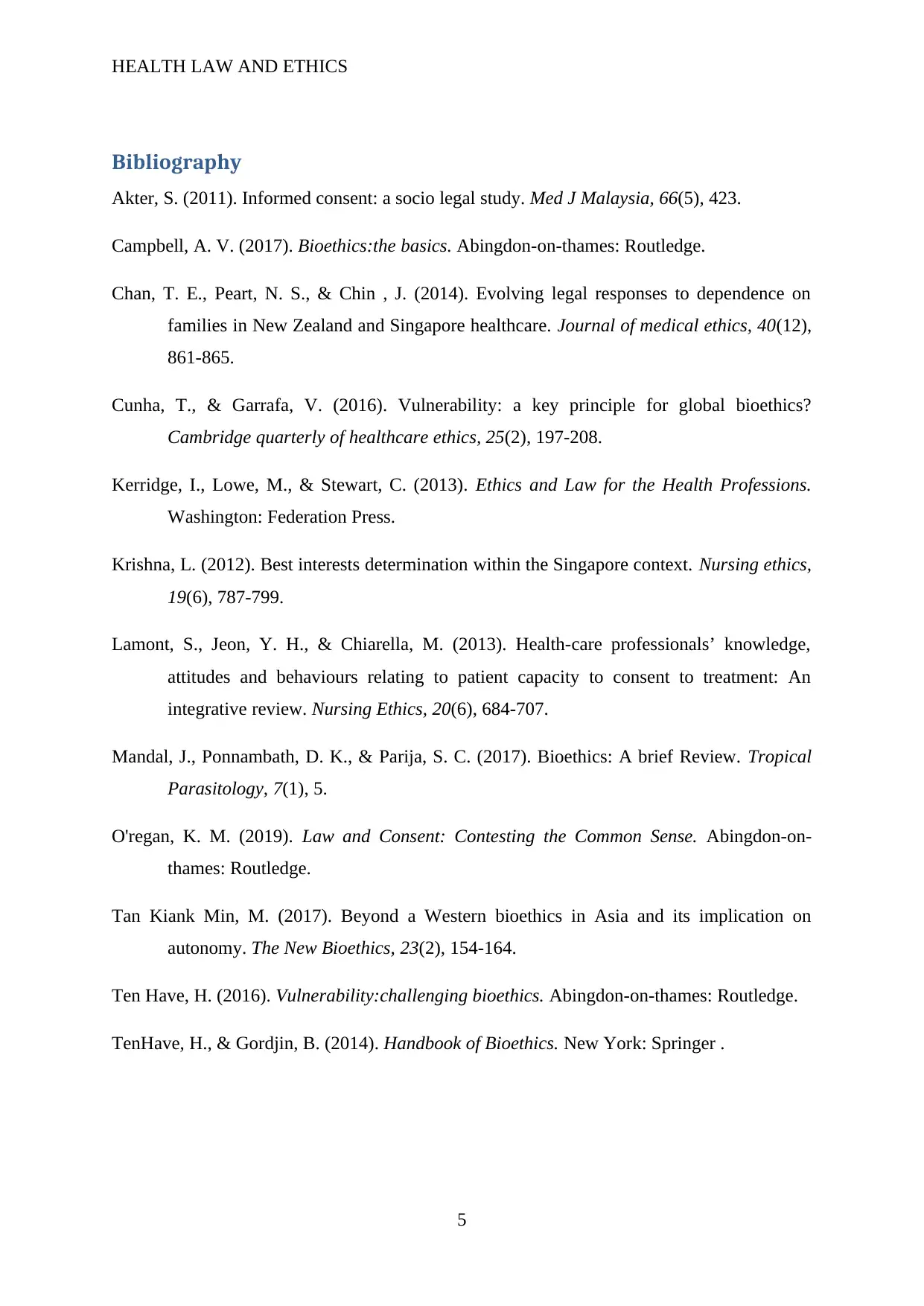
HEALTH LAW AND ETHICS
Bibliography
Akter, S. (2011). Informed consent: a socio legal study. Med J Malaysia, 66(5), 423.
Campbell, A. V. (2017). Bioethics:the basics. Abingdon-on-thames: Routledge.
Chan, T. E., Peart, N. S., & Chin , J. (2014). Evolving legal responses to dependence on
families in New Zealand and Singapore healthcare. Journal of medical ethics, 40(12),
861-865.
Cunha, T., & Garrafa, V. (2016). Vulnerability: a key principle for global bioethics?
Cambridge quarterly of healthcare ethics, 25(2), 197-208.
Kerridge, I., Lowe, M., & Stewart, C. (2013). Ethics and Law for the Health Professions.
Washington: Federation Press.
Krishna, L. (2012). Best interests determination within the Singapore context. Nursing ethics,
19(6), 787-799.
Lamont, S., Jeon, Y. H., & Chiarella, M. (2013). Health-care professionals’ knowledge,
attitudes and behaviours relating to patient capacity to consent to treatment: An
integrative review. Nursing Ethics, 20(6), 684-707.
Mandal, J., Ponnambath, D. K., & Parija, S. C. (2017). Bioethics: A brief Review. Tropical
Parasitology, 7(1), 5.
O'regan, K. M. (2019). Law and Consent: Contesting the Common Sense. Abingdon-on-
thames: Routledge.
Tan Kiank Min, M. (2017). Beyond a Western bioethics in Asia and its implication on
autonomy. The New Bioethics, 23(2), 154-164.
Ten Have, H. (2016). Vulnerability:challenging bioethics. Abingdon-on-thames: Routledge.
TenHave, H., & Gordjin, B. (2014). Handbook of Bioethics. New York: Springer .
5
Bibliography
Akter, S. (2011). Informed consent: a socio legal study. Med J Malaysia, 66(5), 423.
Campbell, A. V. (2017). Bioethics:the basics. Abingdon-on-thames: Routledge.
Chan, T. E., Peart, N. S., & Chin , J. (2014). Evolving legal responses to dependence on
families in New Zealand and Singapore healthcare. Journal of medical ethics, 40(12),
861-865.
Cunha, T., & Garrafa, V. (2016). Vulnerability: a key principle for global bioethics?
Cambridge quarterly of healthcare ethics, 25(2), 197-208.
Kerridge, I., Lowe, M., & Stewart, C. (2013). Ethics and Law for the Health Professions.
Washington: Federation Press.
Krishna, L. (2012). Best interests determination within the Singapore context. Nursing ethics,
19(6), 787-799.
Lamont, S., Jeon, Y. H., & Chiarella, M. (2013). Health-care professionals’ knowledge,
attitudes and behaviours relating to patient capacity to consent to treatment: An
integrative review. Nursing Ethics, 20(6), 684-707.
Mandal, J., Ponnambath, D. K., & Parija, S. C. (2017). Bioethics: A brief Review. Tropical
Parasitology, 7(1), 5.
O'regan, K. M. (2019). Law and Consent: Contesting the Common Sense. Abingdon-on-
thames: Routledge.
Tan Kiank Min, M. (2017). Beyond a Western bioethics in Asia and its implication on
autonomy. The New Bioethics, 23(2), 154-164.
Ten Have, H. (2016). Vulnerability:challenging bioethics. Abingdon-on-thames: Routledge.
TenHave, H., & Gordjin, B. (2014). Handbook of Bioethics. New York: Springer .
5
1 out of 6
Related Documents
Your All-in-One AI-Powered Toolkit for Academic Success.
+13062052269
info@desklib.com
Available 24*7 on WhatsApp / Email
![[object Object]](/_next/static/media/star-bottom.7253800d.svg)
Unlock your academic potential
© 2024 | Zucol Services PVT LTD | All rights reserved.



